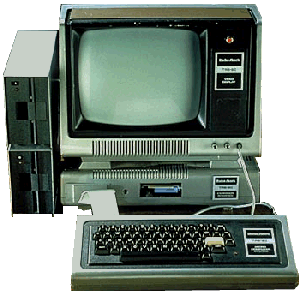Radio Shack has gone bankrupt, which makes me feel a little guilty
since in recent years I have traveled more frequently online or to Best Buy. But in the early decades of this
journal, Radio Shack was our technological guardian angel. Here were a couple of
our favorite devices– Sam Smith
The Trash 80
CNET,
2013 - Lewis Kornfeld, who died Friday at the age of 97 in Fort Worth,
Texas, was the president of Radio Shack in 1977 when he saw a grand future for
the personal computer.
When
Kornfeld and Radio Shack debuted the TRS-80 in 1977, the personal home computer
market was wide open. With no major player dominating consumer's pocketbooks,
and no perceived consumer need for this technology, the future was unknown.
The TRS-80 microcomputer was priced at just $599.95 and stood in stark contrast to the build-it-yourself machines available to super technical hobbyists at the time. It was a rudimentary machine by today's standards, but it was a revolution in all-in-one technology and price at the time.
When it launched, consumers went wild, and the TRS-80 was backordered for months, ultimately selling nearly twice as many units as Radio Shack had originally projected.
Introducing affordable electronics to America including computers, stereo receivers, and cellular phones, Radio Shack arguably did more to promote the culture of digital consumerism in the United States than any other company.
The TRS-80 microcomputer was priced at just $599.95 and stood in stark contrast to the build-it-yourself machines available to super technical hobbyists at the time. It was a rudimentary machine by today's standards, but it was a revolution in all-in-one technology and price at the time.
When it launched, consumers went wild, and the TRS-80 was backordered for months, ultimately selling nearly twice as many units as Radio Shack had originally projected.
Introducing affordable electronics to America including computers, stereo receivers, and cellular phones, Radio Shack arguably did more to promote the culture of digital consumerism in the United States than any other company.
The Model 100
Many editions of the Review, then the DC Gazette,
were composed on a Model 100 and the editor's wife wrote her 200 page master's
thesis on a Model 200 which had an external disc drive that could only handle
three pages per disc.
Sam Smith, DC Gazette
1983 - Although the Gazette is,
so-to-speak, computerized, our
particular device — a Radio Shack Model 100 — uses a liquid crystal display, a sort: of blown up
version of what you see on a digital
watch. Having used both the LCD and the
VDT, I can tell you that the difference is
quite astounding. I find that typing on a LCD (like right now) is even
less tiresome than typing on a piece of
paper. I can adjust the brightness of the screen to my inclinations, the type is roughly twice
the size of normal typewriter characters
and there is none of that annoying
space-age flicker and glare you find on a VDT.
The screen is only eight lines by 40 characters, but I suspect that full-scale LCD screens will be available before too long. Incidentally^ the Radio Shack 100 is a phenomenal device which is only 8"xll"x2", can be run on four AA batteries, and, with 24 built-in file slots, an internal modem for telephone communications,and other goodies, I can set the Gazette, pay bills, do accounts with a 13 column by 18 row spreadsheet and keep a self-dialing telephone directory — lounging in my favorite chair all the while. The main thing I have to watch out for is that I don't spill my drink on the keyboard.
The screen is only eight lines by 40 characters, but I suspect that full-scale LCD screens will be available before too long. Incidentally^ the Radio Shack 100 is a phenomenal device which is only 8"xll"x2", can be run on four AA batteries, and, with 24 built-in file slots, an internal modem for telephone communications,and other goodies, I can set the Gazette, pay bills, do accounts with a 13 column by 18 row spreadsheet and keep a self-dialing telephone directory — lounging in my favorite chair all the while. The main thing I have to watch out for is that I don't spill my drink on the keyboard.
Old Computers – The Tandy 100 was actually a computer made in Japan by Kyocera. All the ROM programs were written by Microsoft, and even a few of them were written by Bill Gates himself These programs include a text editor, a telecommunication program, which uses the built-in modem (300 baud), and a rather good version of BASIC. . . The operating system uses 3130 bytes of the 8 KB RAM. So the 8 KB models didn't sell very well. But there was also a 24 kb model. . . The CMOS CPU allows [people] to use the Tandy 100 for 20 hours with only 4 AA batteries. The model 100/102 is still considered and used as an excellent machine, mainly to type texts when you're on the move (you can transfer them to modern computers) and even to send and receive emails.


2 comments:
I scraped and scrounged to get together enough extra cash to purchase my first PC, which was the TRS-80 CoCo2 with cassette storage. That was in the summer of '84. I think it was in '91 when I came across an IBM PS/1, running Windows 3.1. I remember my son came home excited about a Sim City game he brought home from a birthday shopping trip with my wife. The game's size was 4GB and there wasn't enough on-board memory to run it. It totally let the air out of his birthday balloon. Great stroll down memory lane. :-)
The TRS-80 was my first exposure to computers - loading programs by cassette tape, which worked about 70 percent of the time.
One of the best games is online here: http://santaparavia.com/Home.aspx
Post a Comment